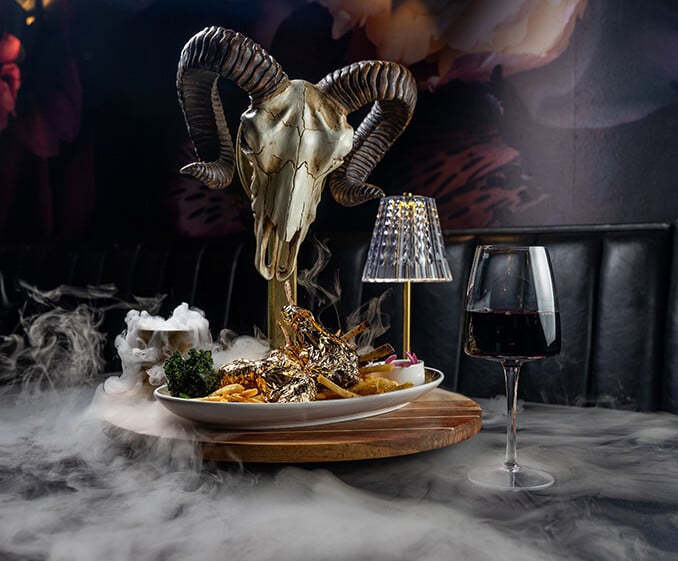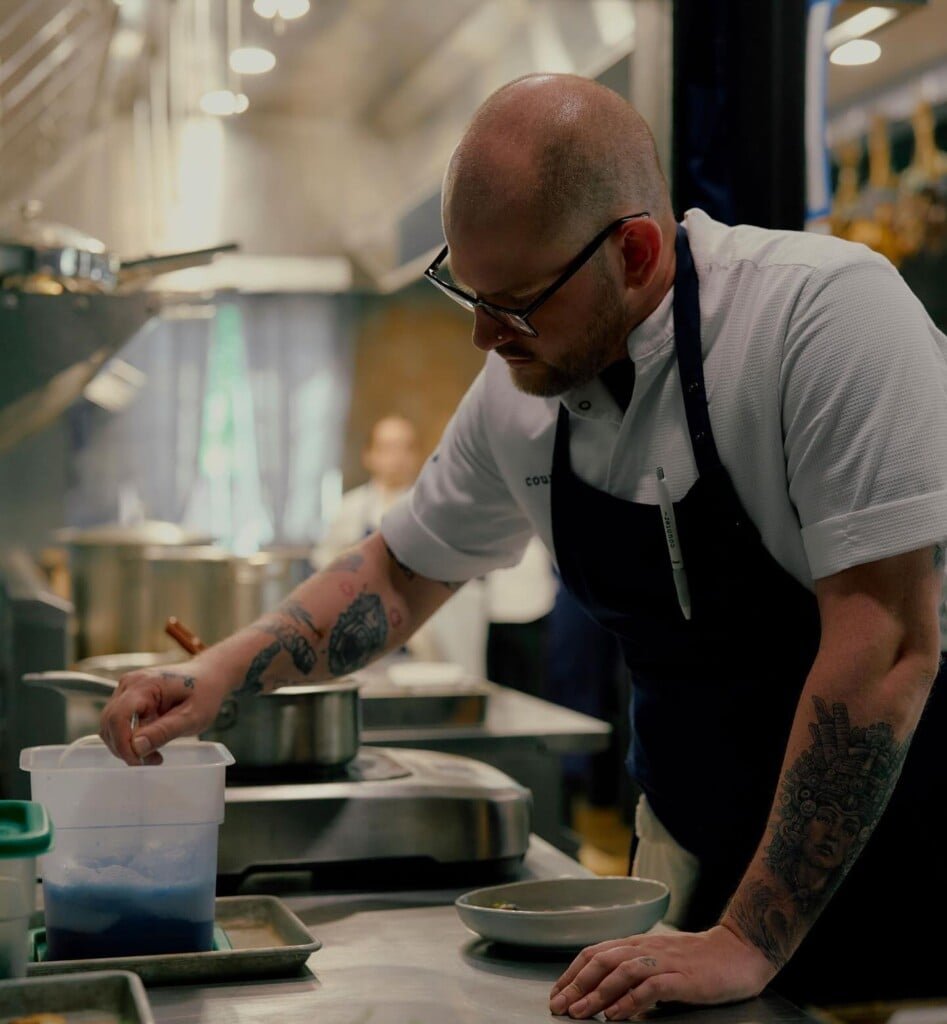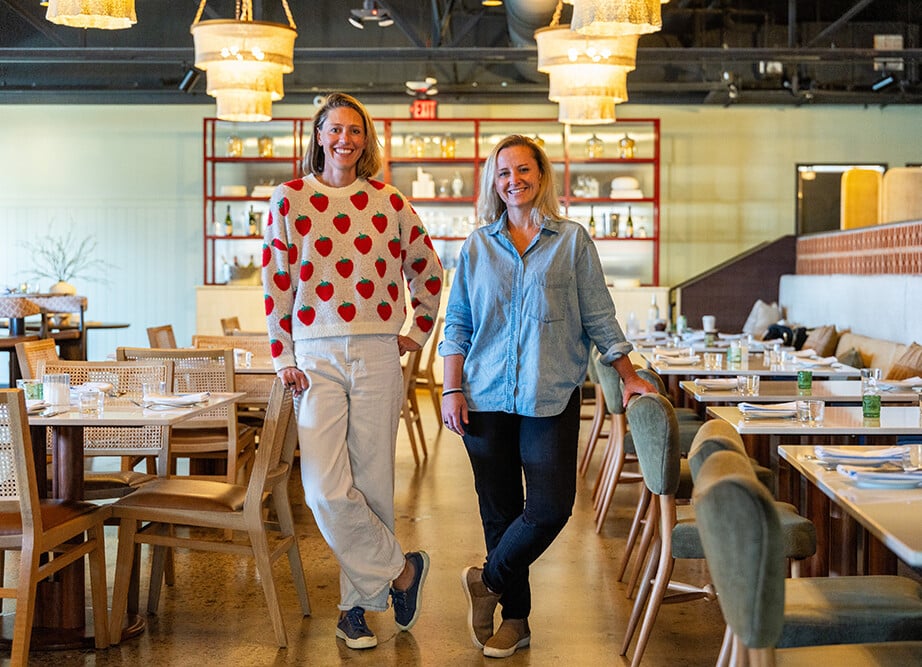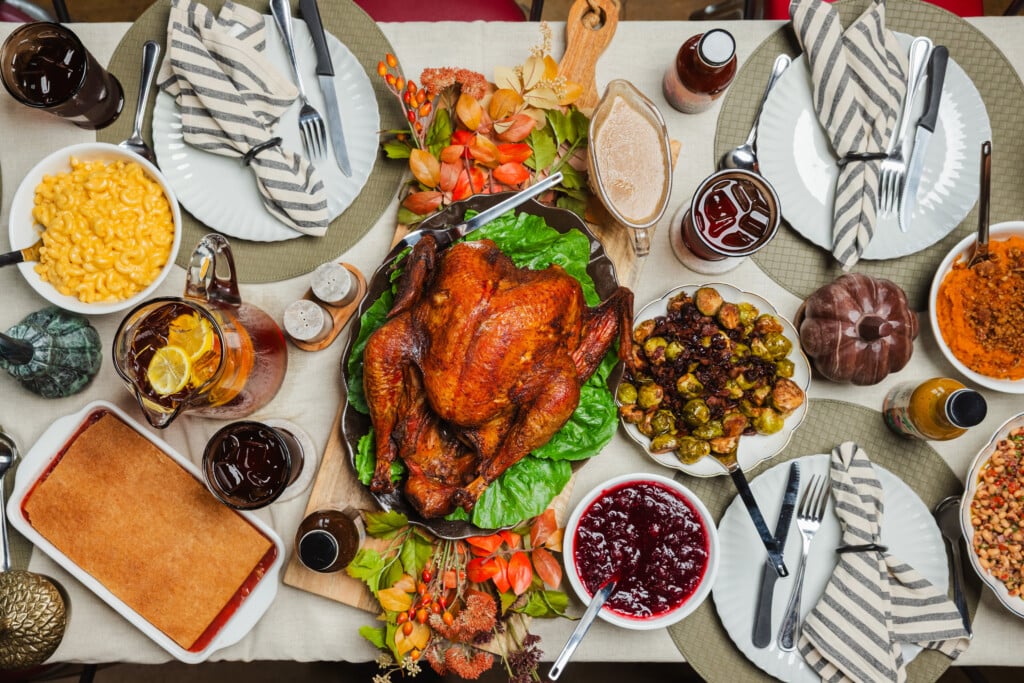The Charlotte Restaurant Scene: Go Big or Go Lean?
The two-punch combo of COVID and influencer culture has forced many restaurants to make a choice: a flashy, Instagrammable experience or a no-frills, low-overhead takeout spot with unique, often ethnic dishes. What’s that mean for a city that’s just starting to piece together the ingredients of its food scene?

Greg Pappanastos, a former DJ who works in commercial real estate, has owned the building at 130 W. Bland St. since 2009. Until last year, he says, “it was a dirty, old warehouse with an uneven concrete floor and brick walls covered in plaster.” But he knew the South End location was a huge asset, and he thought he could renovate the space without losing its character. He also knew he couldn’t rely on just good food and drinks to get people in the door. He’d have to create an experience unlike anything else in Charlotte.
“Post-COVID, our collective patience diminished considerably,” Pappanastos says. “You see that everywhere, from the grocery store to the interstate to the restaurant experience. You have to be cunning and sharp when you’re offering people a night out on the town. I don’t want to be relegated to a dinner-only experience until 9 p.m.”
Pappanastos, along with partners Nick Spain and Jay Pound, opened Orosoko Sound Bar, a 40-seat restaurant and cocktail lounge, last April. The 2,300-square-foot interior has exposed brick walls, custom leather cushions, a vapor fireplace, and a Buddha-head fountain from Southeast Asia. Colorful cocktails have ingredients like matcha, cold brew, and sake, and Pound, who previously led the kitchen at Soul Gastrolounge, created a menu of eye-catching, global-inspired plates. It’s the kind of place that looks phenomenal on Instagram.

Orosoko’s high-end sound system. “‘Oro’ is gold in Spanish, and we’re adjacent to the gold district. Soko is ‘warehouse’ in Japanese,” says owner Greg Pappanastos. “I wanted to create some mystique and wonder.”
Across town in Wesley Heights, a nondescript brick building save for the orange frame around the door, houses 20 rentable cooking stations. It’s the restaurant industry’s version of a coworking space. Inside those walls is something diners don’t typically see: Stripped-down, sometimes cramped spaces where chefs prepare some of the most creative food in the city. Some are restaurant owners who’ve had to scale back operations following the pandemic; others are testing new concepts before they commit to a brick-and-mortar. Meals come in Styrofoam containers with plastic utensils. Presentation isn’t the point here.
At Orosoko, the most notable feature isn’t visible, either. In every square inch of the ceiling, soundproofing insulation absorbs ambient noise, and walnut sonic diffusers hang from the ceiling to enliven the audio. The interior has no hotspots or dead spots—even in the restroom. Behind the DJ booth is a private table surrounded by motorized drapes for A-list guests who require privacy. (Pappanastos won’t drop any names, but he says he’s already hosted a few.) “We’ve done what no one in Charlotte has done in terms of sound,” Pappanastos says. “It’s a conversation piece before you even get the food.”
For years and generations of Americans, dining out usually meant going to a neighborhood restaurant for a decent meal at a reasonable price. Places like Chili’s, Red Lobster, and Denny’s—chains that catered to suburban diners—were built on this idea. You had your special-occasion spots and your drive-thrus, but plenty of restaurants were midrange and accessible to the masses.
Then came COVID, and no one ate out. Many restaurants shifted to takeout—if they got by at all. Here and nationwide, dining behavior changed. The pandemic may not be the single cause of this shift, but it was certainly an inflection point in Charlotte. If the closings last year of Zada Jane’s and Village Tavern are any indication, the middle-of-the-road restaurants may be on their way out.
Last summer, Harper’s Restaurant closed after more than three decades in its SouthPark location. It was one of Charlotte’s legacy restaurants, known for an affordable menu of burgers, ribs, and wood-fired pizzas. When the landlord of Sharon Corners decided to demolish the building that housed Harper’s and replace it with a bank, owner Tom Sasser had no choice but to close. He’d like to reopen in another location at some point, but it’s not easy in SouthPark or its surrounding neighborhoods—even with his track record.
“There are still some (midrange restaurants) around, but my guess is most probably own their own real estate, so they can control their destiny,” he says. “If you’re leasing, you’re at the mercy of the property owner. You have to be the latest and greatest to get attention. If you’re doing a good, consistent job, that’s not what’s promoted now. That’s not what’s sexy or exciting. Everyone wants to go to the place that opened last week.”
Midrange chains across the country are feeling the squeeze, too, as takeout takes off. Outback Steakhouse, MOD Pizza, and Applebee’s all cited underperformance as the main reason for closing locations in 2024. Buffalo Wild Wings closed 60 U.S. locations last year; IHOP closed 100. In November, TGI Fridays filed for Chapter 11 bankruptcy. A 2023 Deloitte survey showed that 60% of consumers are unlikely to accept lesser quality when ordering takeout. A growing number of customers use third-party apps like DoorDash and Uber Eats, and 52% of respondents indicated they would order from a ghost kitchen that offers takeout and delivery only.
This shift in consumer demand widened the opening for ghost, or cloud, kitchens—spaces with no dine-in areas or visible storefronts, even before COVID. CloudKitchens, started by former Uber owner Travis Kalanick, scooped up more than 40 properties in two dozen U.S. cities over two years, The Wall Street Journal reported in 2020. But the trend surged especially during lockdown, when online ordering became the default.
South End Eats, which opened in Charlotte in 2022, is an offshoot of this trend. The food hall on West Summit Avenue houses about 30 small kitchens where chefs prepare takeout meals, which customers pick up from lockers. Hours are 11 a.m. to 11 p.m., and customers order through on-site touch screens or Uber Eats, DoorDash, and Grubhub. City Kitch reflects the same idea. The commercial kitchen, with locations in University City, Wesley Heights, and Greensboro, has rentable cooking stations where chefs can test new menu concepts without the long-term commitment of a building lease. In Wesley Heights, the lobby has a wall of ordering kiosks, like a digital food hall, with tenants that include Boujee Soul Food, Crav’n Caribbean, and Mariah’s Taco Spot. Customers can place their orders and wait at one of the three high-top tables until a chef delivers their meals. To collect mobile orders, they scan the QR codes to the right of the kiosks to let the kitchen know they’ve arrived.
“We speak to the adventurous foodie who spends a lot of time on social media, thinking about the next place they’re going to get a cool plate,” says Erin Lee, until recently City Kitch’s marketing manager. “This is the kind of culture we’re trying to attract. That’s been an aftereffect of the pandemic—with social media, short-form video has really taken over.”
That’s how influencers like Allie Papajohn build their followings. Papajohn launched @eatdrinkclt as a vehicle to explore the city’s dining scene after she moved to Charlotte in November 2014. Ten years later, she has more than 70,000 Instagram followers who habitually visit her page before they decide where to find their next cool plates. The 32-year-old doesn’t just document the food—she informs those decisions.
It wasn’t something she set out to do. “I didn’t even know the word ‘influencer’ when I started this,” Papajohn says with a laugh. Now, she eats out between seven and 10 times a week and aims to visit a mix of buzzy and lesser-known places. Between reels of volcano cocktails and torched nigiri, you’ll find crispy banh mi from food trucks and Korean corn dogs with footlong cheese pulls. No matter where she goes, though, the phone eats first. “When there’s creativity, it’s Instagrammable—even in Styrofoam containers.”

Influencer Allie Papajohn enjoys a bowl of Katsu-don at DŌZO, a Japanese American food stall inside City Kitch.
In general, she says, elaborate dishes don’t perform better than meals in takeout boxes. It’s more about what’s trending, new to Charlotte, and looks good on video. “I’ve always found food beautiful and photogenic, so that’s never been an issue for me trying to capture it,” she says. “I was late to hop on TikTok and make reels. But showing food in action has made restaurants lean more heavily toward that.”
It’s why a video of a parmesan shower atop the Penne alla Vodka from Little Mama’s garners thousands of views. And it’s how first-timers know to order the Okonomiyaki and Katsu-don from DŌZO, the 600-square-foot Japanese American food stall inside City Kitch. Papajohn and other influencers posted about DŌZO after it opened in September, which helped lead to near-constant wait times for the 12-seat space.
City Kitch was, in many ways, ahead of its time. Former Johnson & Wales instructor Carrie Hegnauer opened the first location in 2013 as a shared kitchen near UNC Charlotte. “It was founded as this home for food trucks during the food truck craze of the mid-2010s,” Lee says. By 2020, City Kitch’s management had changed hands, and it expanded to Wesley Heights. The following year, the third location opened in Greensboro.
“In a lot of ways, it’s the combination of us being well positioned to take advantage of an opportunity in the market, plus COVID made us shift to the takeout format,” Lee says. “We were really thinking about how differently people are eating and saw that natural change in who was approaching us. It was an opportune moment of two things happening at the same time.”
Some tenants, like Sun’s Kitchen, work at City Kitch for a few years before they make the leap to a brick-and-mortar. For others, that’s not the goal. Crav’n Caribbean wanted to remain a takeout space and opened a second ghost kitchen at City Kitch’s Greensboro location. In 2023, longtime restaurateur Fran Scibelli closed Fran’s Filling Station after a decade in Dilworth and rented a cooking station at the Wesley Heights location to keep filling catering orders. When Leah & Louise outgrew its kitchen at Camp North End, owners Greg and Subrina Collier expanded their back-of-house operations to the University location.
Many of Charlotte’s most successful restaurants, including L’Ostrica, Restaurant Constance, Counter-, and Meshugganah, have used City Kitch as a launchpad. Instead of spending hours on admin and money on staff and other overhead, chefs can do what they love. “They’re in the kitchen up to 70 hours a week, so they help each other out and find camaraderie and ask other chefs questions,” Lee says. “We recently had two ghost kitchens collaborate on a pork cheesesteak.”
With 117 people moving to the Charlotte area each day, it’s pushing these operators to expand their offerings, too. New York transplants might miss bodegas, while Texans could crave breakfast tacos. Meanwhile, influencers are always on the hunt for the latest TikTok trend. Last summer, it was fufu, a West African dish made from pounded cassava or yam—and now available at City Kitch’s Greensboro location.
At Deluxe Fun Dining in uptown, meals are full-on spectacles with edible gold, dry ice, and blowtorches. Popcorn Shrimp is served in a popcorn machine, Lobster Puffs arrive in a tabletop oven, and Australian Lamb is wrapped in gold leaf. The Bloody Mary is an entire meal (with a whole lobster!) stacked atop the savory cocktail. They also have an in-house magician and samba dancers on Saturdays.
While many cities’ restaurants have embraced food presentations as a kind of theatre, Las Vegas (where else?) was at the forefront. At Morton’s The Steakhouse, the menu includes 2-pound porterhouses that are sliced tableside, a flaming baked Alaska, and a $1,200 dry-aged tomahawk steak that can feed 12 to 14 people. The production began touring: In New York City, Lebanese restaurant Au Za’atar serves tableside shawarma on a rotating vertical spit. At Kaviar, a Japanese restaurant in Pasadena, California, guests come for flame-torched sushi rolls, liquid nitrogen cocktails, and the signature Truffle Toro, which is topped with black Kaluga caviar and 24-carat gold.
It’s now playing all over Charlotte. Oak Steakhouse, a fixture in SouthPark since 2017, recently rolled out its own tableside presentations. The restaurant serves cocktails with smoky infusions for dramatic effect—like The Volcano, with Volcán Blanco tequila, Grand Marnier, a spice blend, cranberry, and lime—and S’mores, which comes with a tabletop cookout where guests roast their own marshmallows. Constantine’s Restaurant in Gastonia serves hot bread with a candle made of butter and Testi Kebab in a flaming clay pot. Runaway Whiskey & Wine makes cocktails with dry ice and liquid nitrogen to create smoke and fog. Ricko’s Churro Bar, which opened last summer in NoDa, serves mammoth made-to-order churros looped inside cups of soft serve with syringes of chocolate sauce.

Oak Steakhouse’s tableside presentations include The Volcano (above), with Volcán Blanco tequila, Grand Marnier, and a smoky infusion for dramatic effect; and S’mores, with a tabletop cookout (below) where guests roast their own marshmallows.
At Deluxe Fun Dining, co-owner and Kazakhstan native Tatyana Khom created many of the menu items, which are served alongside a piece of decor sourced from around the world: Medieval-inspired helmets, toy bicycles, and carved rabbits that lounge across wooden trays.
The restaurant, originally called Deluxe: The Fine Art of Dining, was open just a few months when the pandemic hit. Once restrictions lifted and diners trickled back in, General Manager John Baylow noticed an unsettling trend: Guests were struggling to make conversation. “We decided to be an ‘icebreaker’ restaurant and help put the spark back into couples’ lives,” he says. “We thought, Let’s bring something out on a fun tray. We wouldn’t have come up with the concept of fun dining if not for COVID.”
They rebranded to Deluxe Fun Dining and shifted their focus to over-the-top presentations. Baylow positioned the uptown restaurant as a place to celebrate birthdays, marriage proposals, and special occasions. He didn’t advertise because he didn’t have to. “At least 50% of our guests said they saw us on TikTok,” he says. “I like to see a billboard, but if my friend or someone I follow tells me it’s really cool, that’s where I want to go. Word of mouth is gold. It takes longer—it took us a year or so—but that word has spread.”
Khom and her team change up the menu a few times a year, and the restaurant’s basement is a treasure trove of bull horns, angel wings, Spartan helmets, and other props they use alongside signature dishes. “We call it our 4D experience,” Baylow says. “It’s like after IMAX when you think, I don’t know if I can go back to a regular movie theater now.”
On Orosoko’s Instagram page are three 60-second animated videos meant to personify the menu. Pappanastos worked with an animator in India to create this storyline for the restaurant to post ahead of its opening. He knew his success would hinge in part on an attention-grabbing social media presence.
Orosoko stays open until 2 a.m. on weekends, and the full dinner menu is available until midnight—another rarity in a city known to shut down after 10 p.m. Chef Pound created an “anti-fusion” menu that’s divided into two parts: East versus West. The Cuban-Style Scallops, for example, mirror the Cherry Blossom Sea Scallops. Blue Crab Burritos are the counterpart to the Blue Crab Steam Rolls. For diners who waited an hour or more for a taste of his glazed pork belly at Soul, he’s worked that into the menu, too.
Pappanastos doesn’t advertise Orosoko—not by traditional means, anyway. He relies on Pound’s stellar reputation and a community that’s hungry for more global influence to keep his tables booked. He also lets his restaurant tell a story, one that mirrors the state of dining in a city that’s still establishing its food scene.
“An Eastern warrior and a Western warrior are in the same city converging on each other,” he says. “It’s an epic battle for your tastebuds.”










